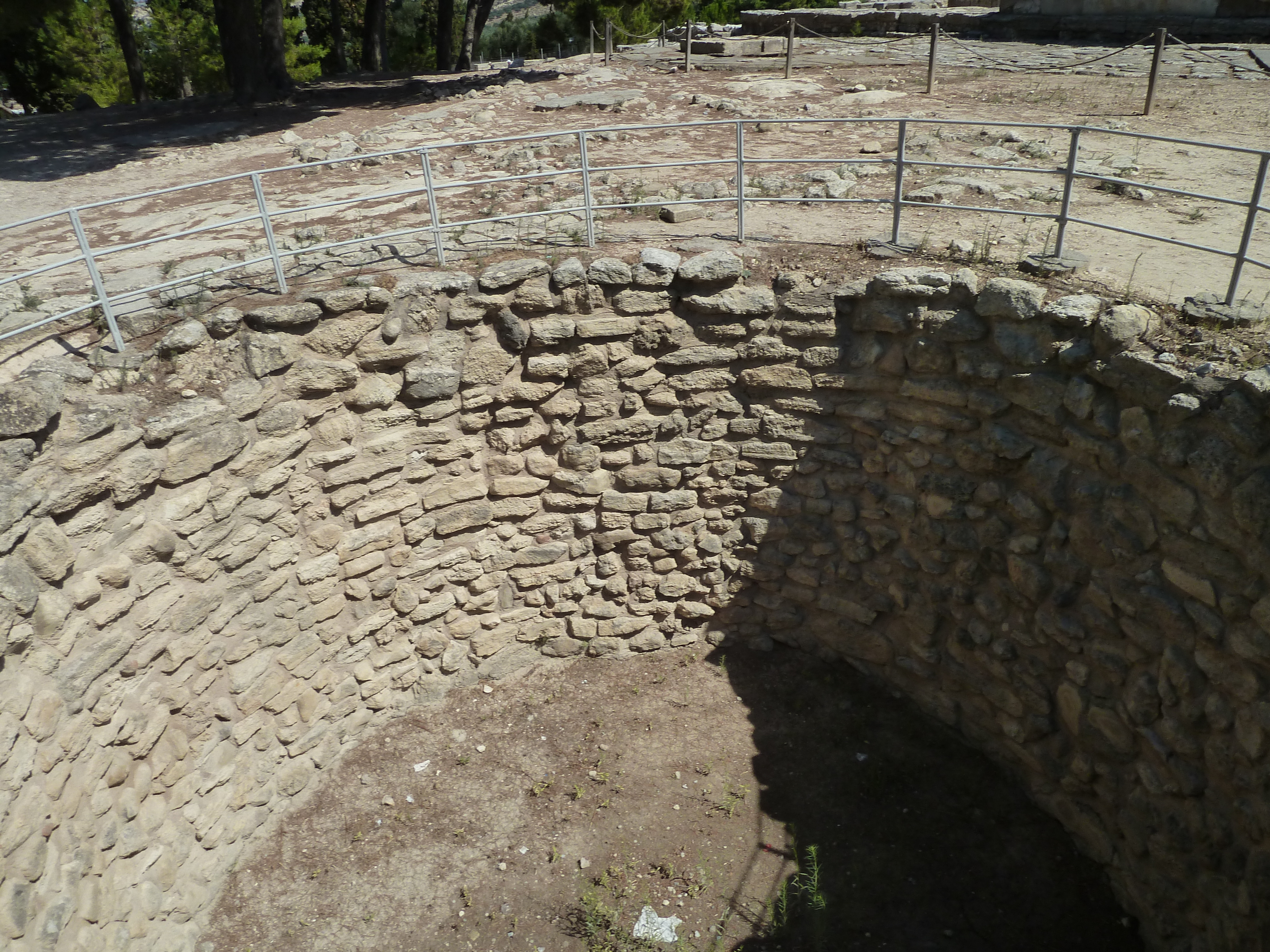Kouloura on:
[Wikipedia]
[Google]
[Amazon]
 A kouloura, or kouloures (Greek plural ''koulourai'') is a circular subsurface pit with stone walls found in certain
A kouloura, or kouloures (Greek plural ''koulourai'') is a circular subsurface pit with stone walls found in certain
settlement
Settlement may refer to:
*Human settlement, a community where people live
*Settlement (structural), the distortion or disruption of parts of a building
*Closing (real estate), the final step in executing a real estate transaction
*Settlement (fina ...
s within Ancient Crete, including Phaistos
Phaistos ( el, Φαιστός, ; Ancient Greek: , , Minoan: PA-I-TO?http://grbs.library.duke.edu/article/download/11991/4031&ved=2ahUKEwjor62y3bHoAhUEqYsKHZaZArAQFjASegQIAhAB&usg=AOvVaw1MwIv3ekgX-SxkJrbORipd ), also transliterated as Phaestos, ...
, Knossos
Knossos (also Cnossos, both pronounced ; grc, Κνωσός, Knōsós, ; Linear B: ''Ko-no-so'') is the largest Bronze Age archaeological site on Crete and has been called Europe's oldest city.
Settled as early as the Neolithic period, the na ...
, and Mallia.
According to the stratigraphy
Stratigraphy is a branch of geology concerned with the study of rock (geology), rock layers (Stratum, strata) and layering (stratification). It is primarily used in the study of sedimentary rock, sedimentary and layered volcanic rocks.
Stratigrap ...
, the kouloura were all constructed around MM II (1850–1750 BC).
Etymology
The name ''kouloura'' was coined by Arthur Evans during his expedition to Knossos in 1903. He named the pits after kouloura, the round Greek bread, because of the similar shape of the two objects.Discovery and locations
The first four kouloura were discovered in 1903 atKnossos
Knossos (also Cnossos, both pronounced ; grc, Κνωσός, Knōsós, ; Linear B: ''Ko-no-so'') is the largest Bronze Age archaeological site on Crete and has been called Europe's oldest city.
Settled as early as the Neolithic period, the na ...
by Arthur Evans. Subsequently, discovered eight additional kouloura at Mallia, and the duo of Luigi Pernier
Luigi Pernier (Rome, 23 November 1874 – Rhodes, 18 August 1937) was an Italian archaeologist and academic now best known for his discovery of the Disc of Phaistos.Doro Levi
Teodoro "Doro" Levi (1 June 1899 – 3 July 1991) was an Italian archaeologist who practiced in the Mediterranean countries in the 20th century. Specifically, Levi conducted excavations in Italy, Greece, and Turkey. From 1938 to 1945, Levi wa ...
unearthed four at Phaistos
Phaistos ( el, Φαιστός, ; Ancient Greek: , , Minoan: PA-I-TO?http://grbs.library.duke.edu/article/download/11991/4031&ved=2ahUKEwjor62y3bHoAhUEqYsKHZaZArAQFjASegQIAhAB&usg=AOvVaw1MwIv3ekgX-SxkJrbORipd ), also transliterated as Phaestos, ...
. These pits have always been found within the confines of major sites, including the West Court of Knossos and the Upper Court of Phaistos.
Function
Multiple theories have been put forward regarding the function of these kouloura in AncientMinoan culture
The Minoan civilization was a Bronze Age Aegean civilization on the island of Crete and other Aegean Islands, whose earliest beginnings were from 3500BC, with the complex urban civilization beginning around 2000BC, and then declining from 1450B ...
. However, there are only three majorly supported theories.
* Arthur Evans, the original discoverer of the pits, theorized that they were garbage
Garbage, trash, rubbish, or refuse is waste material that is discarded by humans, usually due to a perceived lack of utility. The term generally does not encompass bodily waste products, purely liquid or gaseous wastes, or toxic waste produc ...
pits due to the lack of cement walling to prevent water seepage.
* Chapouthier and Pernier believed that they were actually ancient cistern
A cistern (Middle English ', from Latin ', from ', "box", from Greek ', "basket") is a waterproof receptacle for holding liquids, usually water. Cisterns are often built to catch and store rainwater. Cisterns are distinguished from wells by t ...
s, based on the presence of a long water trough in one of the kouloura at Knossos. However, the flaw in this theory remains that most of the pits contained no form of waterproofing, a concept which was familiar to other civilizations around this time period.
* The most commonly accepted theory is that the kouloura were a type of granary to store excess harvest. This belief grew out of the fact that kingdoms during the Minoan period grew largely out of ability to store, maintain, and distribute food goods.
See also
*Pithos
Pithos (, grc-gre, πίθος, plural: ' ) is the Greek name of a large storage container. The term in English is applied to such containers used among the civilizations that bordered the Mediterranean Sea in the Neolithic, the Bronze Age and ...
References
Buildings and structures completed in the 19th century BC Buildings and structures completed in the 18th century BC 1900s neologisms Stone buildings Minoan sites in Crete Waste management Reservoirs Granaries {{AncientGreece-stub